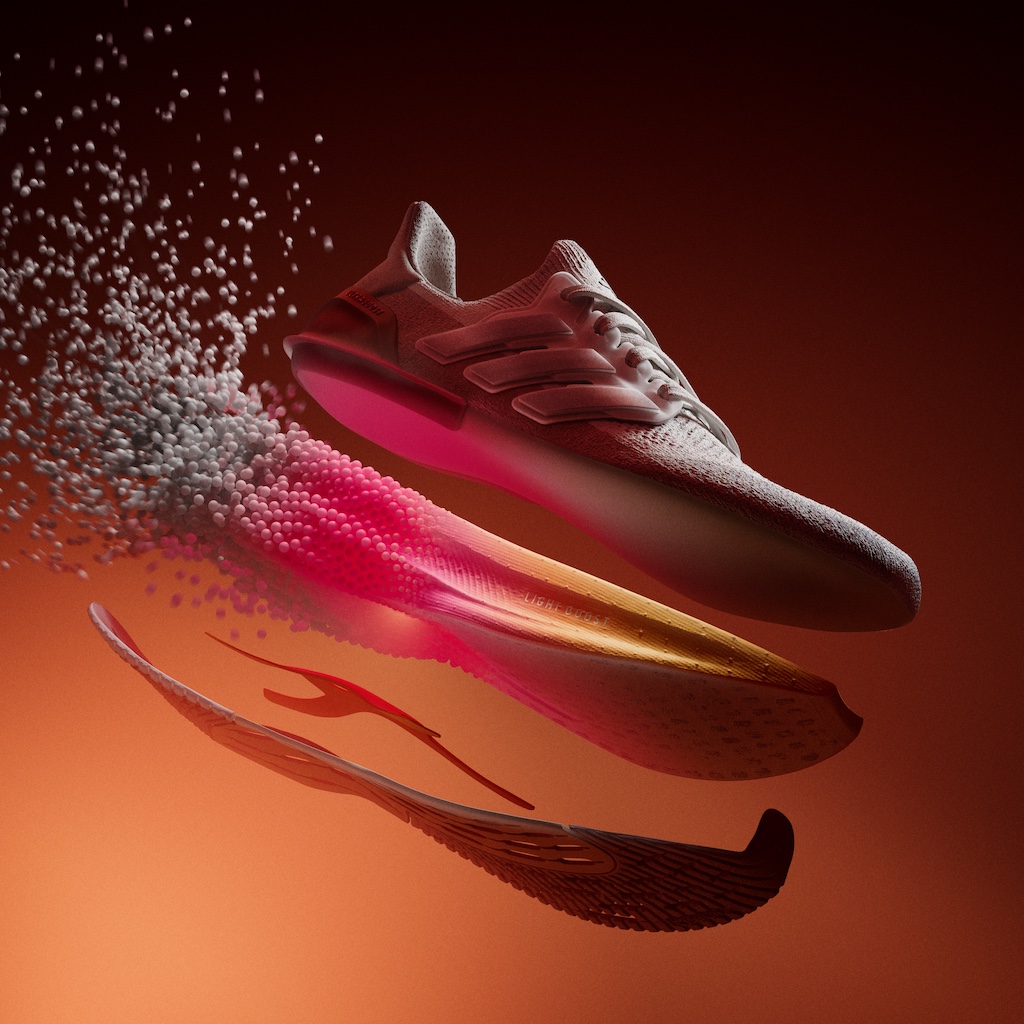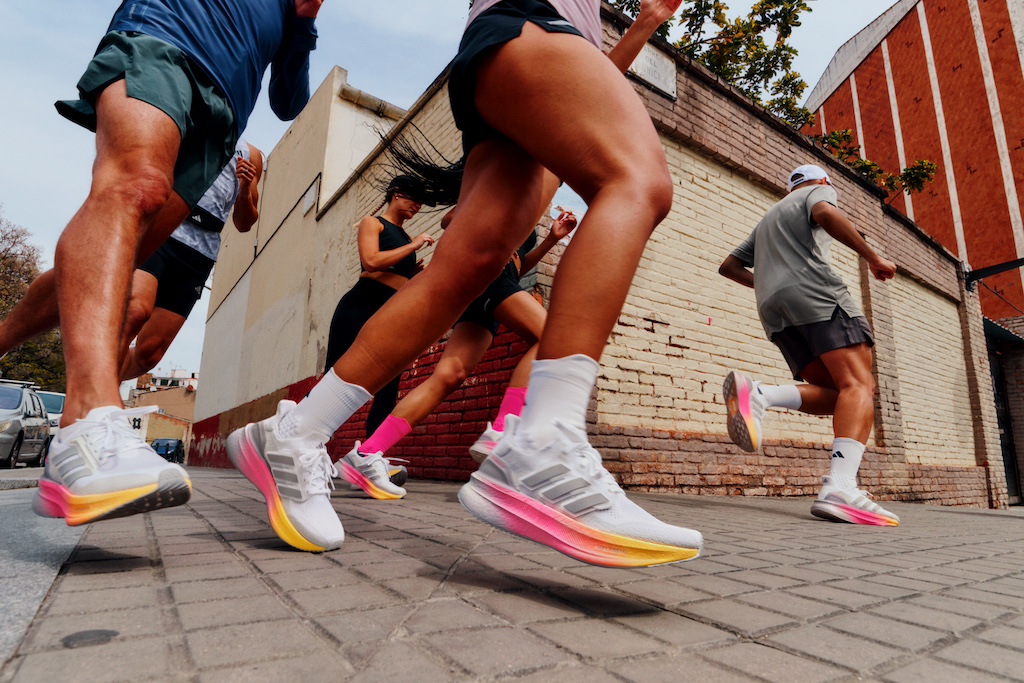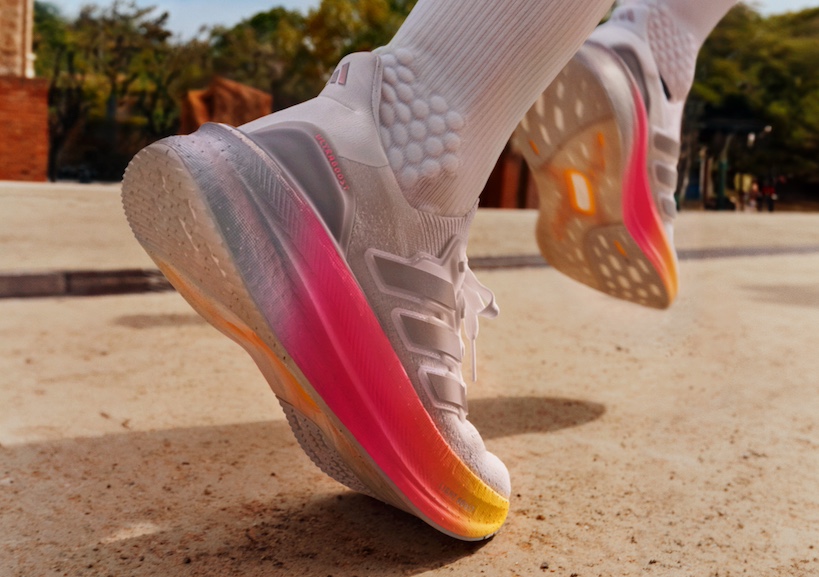The adidas Ultraboost 5 will be on sale on 18 July, and it marks the biggest redesign of the franchise since its 2015 debut.
When adidas launched its original Boost back in 2013 – way before the days of supershoes like the Nike Vaporfly – the bouncy, springy TPU Boost foam was a revelation. It literally propelled running shoes into a new era with its fun, lively, higher-energy, cushioned ride.
I remember marvelling as designers at adidas HQ in Germany bounced metal balls on the new formula foam to show us just how energetic the new magic foam was. The Ultraboost landed two years later with a wedge of Boost foam and was an instant hit.
Since then, every running shoe brand has developed its own recipe superfoam, all shooting for the same Holy Grail: being light, cushioned and punchy. Things moved on in springy leaps and bounds and, by comparison, Boost sort of lost its bounce.
Even adidas developed newer foams for its top-end Adizero race shoes like the Adios Pro 3 (buy now). With the recent launch of the revamped Supernova line, it looked like Boost might end up seeing its days out as retro streetwear. But maybe not.
The Boost is back. Reborn and re-engineered. The new adidas Ultraboost 5 packs a new formula Light Boost foam and puts more of it under your feet to punch up the energy on your runs.
So is it a rebirth? And what’s the difference between adidas’ Ultraboost 5 and the Supernova Prima? Let’s break it down.

adidas Ultraboost 5: what’s new?
The headline here is the new-formula Light Boost foam that we first saw land in last year’s Ultraboost Light (buy now).
The Ultraboost 5 uses the same base material but adidas says it’s been ‘re-engineered to offer reduced weight, significantly higher cushioning and 2% more forefoot energy return than the Ultraboost Light.’ The idea is the midsole springs back quicker as your foot hits the ground, putting more energy into your runs.
A lighter foam also means you can have more of it under your feet and adidas has beefed up the midsole, adding 9mm more foam right across the foot. The Ultraboost 5 has a big 39mm / 29mm stack and a 10mm drop.
Bigger stacks can mean less stability. To combat that, the Ultraboost 5 packs a new torsion system – an X-shaped plate in the middle of the foot – to provide support as you roll from heel to toe. There’s also a moulded external heel counter to add more control.
Up top, there’s a new Primeknit upper with varying levels of structure in the yarn, to provide support where you need it and boost breathability where you don’t. Meanwhile, the outsole features a generous covering of grip and durability-boosting Continental rubber.
What’s the difference between Boost and Supernova
One of the most recent running shoes to feature Boost was the Supernova Boost – a kind of merging of two line-ups. But adidas recently reimagined its Supernova shoes with the launch of the Supernova Rise and the more recent Supernova Prima (buy now). So we now have two shoe lines designed for everyday miles. But what’s the difference?
In a word: foam. The Rise and Prima use a newer PEBA-based Dreamstrike+ foam that’s a slightly denser version of the Lightstrike Pro you find in adidas’ carbon race shoes. Generally speaking PEBA foams offer some of the best energy return.
What runs do they cover? That’s less clear cut. According to adidas, the Ultraboost 5 is built ‘with energised runs in mind’. The brand say it balances cushioning and energy return. A do-it-all shoe with the versatility to handle different types of runs, for different types of runners at all experience levels.
adidas describes the Supernova Prima as a ‘balance of comfort and support to help runners take on their daily runs with ease and distraction free.’
They’re both the same weight. The Prima is listed at 290g compared to the Ulraboost 5 at 292g in a UK size. They have almost identical stack heights, though the Ultraboost 5 has a slightly larger drop: 10mm to the Prima’s 8mm.
With the Ultraboost 5 $30 pricier than the Supernova Prima, it’s going to have to go some to be a better option.

Can Boost bounce back?
I ran in the original Ultraboost way back when and it was a good shoe, offering a very different comfort and energy to the traditional, more bricky EVA shoes. I absolutely loved the adidas Adizero Adios Boost – a shoe that featured a thinner wedge of Boost foam.
But in recent years, better foams – and much better shoes – pushed Boost to the back of the pack on performance. The foam was heavy and less energetic by comparison to new PEBAX and gas-injected foams. The shoes started to feel a bit clumpy and outdated.
At $180, the Ultraboost 5 is close to the top end you can expect to pay for a daily trainer. There are now great shoes that bring energy to your daily miles at that price or cheaper. Shoes with excellent energy, good cushioning and great versatility. The Saucony Endorphin Speed 4 (buy now), ASICS Superblast 2 (buy now), the HOKA Mach 6 (buy now) all hit that sweet spot offering cushioned protection and light, lively rides.
The big question is whether the reborn adidas Ultraboost 5 can live up to those shoes. It’ll certainly have to be better than the most recent Boost shoes. And experience tells me it might not even match the cheaper adidas Supernova Prima, but I’m willing to be proven wrong.
I’ll be testing the shoe out as soon as it’s released, so watch this space for my in-depth review.
adidas Ultraboost 5 price and availability
The Ultraboost 5 goes on general sale on 18 July (adidas adiClub members can get early access from 11 July). The shoe will set you back $180 / £180.






